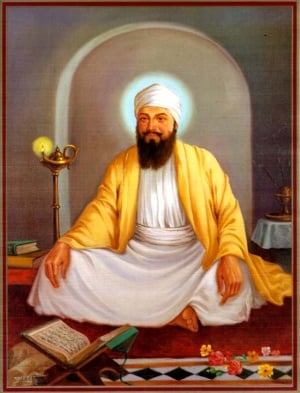The Beheading of Guru Tegh Bahadur
The Emperor Aurangzeb who had seen to the death of his brother and arrest of his father had been raised and educated by the fundamentalist ulema who had long been ignored by his more liberal predecessors. His brother Dara Shikoh had been raised by the Sufis and exposed to the more the more universal side of Islam which, though its aim was still to see everyone in the world submit to Islam, they sought to accomplish their goal by peaceful means. The Sikhs and Hindus were on good terms with the Sufis, but Aurangzeb returned the hated Jizia-a tax which took 60% of everthing from the Sikh and Hindu farmers.
Aurangzeb had decided that he would change India into a land where sharia would rule. He had decided that Islam would be the only religion of India. He would allow no new Hindu temples to be built and he gave orders that many be torn down and replaced by Mosques. A plan was hatched to force the respected Kashmiri Panditss to accept Islam, it was thought that if they converted, the rest of the Hindus would follow. They were told that they would accept or be put to the sword. Records of the time record that some of the Pandits made a pilgrimage to Amarnath to thecave with the lingham of Shiva. Their they had a vision of Shiva who told them to travel to see Guru Tegh Bahadur. Guru Tegh Bahadur was the ninth in the line of Guru Nanak and lived at Anandpur Sahib in Punjab, Northern India. They resolved to go to him and ask for his protection.
After a long and hard Journey, they arrived at the Guru's court. They told him their sad story. They said, "Your very name has the power to bring comfort to those in need. The purpose of your life is to protect religion. Please help us to save our faith." As the Guru sat silently absorbed with their request, his son, young Gobind Rai, came in and, seeing his father sitting quietly, went up to him. The Guru said nothing, but tenderly embraced the boy. Guru Ji’s 9 year old son Gobind Rai Ji told his father what the problem was. The Guru told his son of the Pandits dilema and said that it would take a holy man literally laying down his life to intercede. Gobind Rai responded “Who would be better than you to defend the poor Brahmins”. Guru Tegh Bahadur Ji decided to stand up for the right of freedom of worship and told the delegation to tell Aurangzeb that if he could convert Guru Tegh Bahadur they would gladly convert.
He had word sent to Delhi with a proposal for the emperor: "If you can convince Guru Teg Bahadur, ninth Sikh Guru, who is now seated on the throne of Guru Nanak to accept Islam then all the Kashmiris will accept your faith."
So began the course of events which led to the martyrdom of Guru Tegh Bahadur. In the end, as he was about to be beheaded, he tied a small note on a string around his neck. With a knowing look, he told the watching crowd that he was about to perform the miracle they had all been waiting for. This string had magical powers: it would prevent the executioner from cutting off his head. Up, then down swung the executioner's axe. Off came Guru Teg Bahadur's head.
When his head was severed, the note was read. It said, "I gave my head, but not my faith."
With this Sakhi it learnt the difficult lesson for all Sikhs to protect the weak, even if it means that the head has to be given. Because of this sacrifice Guru Tegh Bahadur is called "The Protector of Hindus" - 'Hind di Chader'

